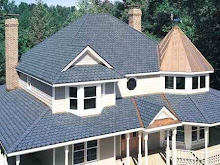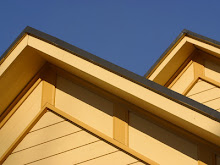Saturday, August 22, 2009
Atlanta Roofers Tips
It is that time of year again where Atlanta residents must ensure their roof is in good condition prior to the rain storms
caused by the remnants of hurricanes that pound the coasts of FL, GA, and AL! Many residents of the Atlanta are need a consultation from a qualified and professional Atlanta Roofer to ensure that their family will be safe from the terrential downpours, and violent hail that usually invades the Atlanta Area late August through the end of the year. How can you know if your roof needs repairs? Here are some general tips - if you spot these - call an Atlanta Roofer:
Curled up Shingles
Worn Off Granules
Loose or missing Shingles
Cracked Shingles
Spots on your interior ceiling
Green or Bleack Streaks
Age of the roof - over 15 years old
Sometimes homeowners are weary about hopping on the roof themselves to gain a closer look at potential issues that could lead to leaks, tears, etc. in their roof, and catastrophic damage during the next major storm. For those customers that do not feel comfortable, or simply do not have the time to hop on their roof, there are local companies that will offer free roof inspections to residents of Atlanta. Atlanta Professional Roofers offers same day service as well as free estimates and free roof inspection!
Some of the common reasons that roofs "fail" are the folowing:
Leaks
Poor workmanship
Lack of Maintenance
Storm / weather damage
What is important to know is that most roof failure, from leaks to cave ins can be prevented by ongoing maintenance provided by a local Atlanta Roofer on a bi-annual basis. Many of us dont think about the elements our roofs have to face on a daily basis, however think of the intense rain, hail, wind, sun in Atlanta! Daily exposure to the elements can take its toll - in order to prolong the life of your roof, make sure you have it inspected regularly and save money in the long run!
Wednesday, August 5, 2009
Great Article from Do It Yourself
1. Check out the Most Likely Roof Leak Spots
The most likely places where you will get a roof leak are the chimney, plumbing vent flashing, ice dams, skylights, wall step flashings, furnace shingles, fields of shingles and missing shingles. It may be difficult for you to identify the problematic area in the absence of rain or snow and therefore you may have to do the identification during wet weather.
Apart from these leak hot spots, your roof may leak because it simply because it is worn out and needs a complete overhaul.
Most leak spots are never directly above the location where the dripping occurs on the ceiling. For this reason, locating the exact spot may require you to start in the attic. Here, you can locate a spot that lets in the sun’s rays or alternatively you can have a partner water the roof so that you can identify where the dripping goes through. Following leak stains is another way to find leak spots. Leak stains will normally be observed around skylights, chimneys, and vents.
2. Emergency Roof-Leak Repair Measures
Sometimes it just happens that a leak emerges right in the middle of a shower. You can take care of this by using plastic sheeting to cover the leak area on the roof. This sheeting needs to be stapled onto two 2 by 4s that can then be nailed along the eaves, climbing over the roof ridge, and some feet below on the other side of the roof. This should adequately cover the entire leak area.
3. Temporary Repair for Roof Leaks
Once you have identified the leaking spot you may as well start implementing some temporary repair measures. Such measures may involve climbing to the roof armed with tools like a hammer and some nails, and materials like tar and flashing.
Fixing the leak spot in this manner may suffice for a wet night but more repair work needs to be done if the problem is to be completely solved.
4. Repairing Leaks in Shingle Roofing
One of the easiest leaky roof repair jobs that you can do is when the problem is identified as bent-back shingles. Here, the solution involves replacing the damaged shingles. Remove the layer of shingles above the damaged ones and then replace them with new ones.
5. Problems with Collars and Flashings
Pipes are also a major cause of leaking roofs and the troublesome spots will mostly involve the collars and flashings. These immediately call for new replacements. Pipe leaks may also require some extra work in terms of observing if the wood beneath the roof is soft from water damage. Such wood surfaces do rot with time and thus they become unreliable. The situation may require you to re-roof the house depending on the extent of the damage.
Tuesday, August 4, 2009
Atlanta Area Roofing Tips
Leaking roofs can usually be repaired quite barely depending on how severe the damage to the roof is. By locating the general area of the roof leak on your home the problem can be isolated and fixed fairly easily. Most roof repair contractors can locate the cause of a roof leak quickly and will often explain the problem in wrong way.
The source of the roof leak is not always obvious. A leak may not be directly above the water stain on the ceiling or the wet spot on the attic floor; it may travel horizontally under the shingles and then down the roof sheathing before penetrating at a seam. Some apparent “leaks” may in fact be condensation on the underside of the roof caused by inadequate attic ventilation.
It helps to know the most common leak locations. The most obvious ones are wherever the roofing is visibly missing or damaged, but more often leaks occur at flashing points (valleys and roof penetrations). In northern climates, where roofs are exposed to snow and ice, roofs that are otherwise in perfect condition may leak in the lower foot or two of the roof when snow and ice build up, forming a dam that collects water from melting snow. If leaks occur only at these locations and under these conditions, the solution lies in preventing the dams (a matter of proper ceiling insulation and eave ventilation).
A roof structure has to be designed in such a way, that no ponding water can take place resulting in a structural failure or permanent deformation of the roof or its parts.
Important factors are here:
Sufficient stiffness of the roof and its components.
Sufficient rainwater discharge possibilities. In case of malfunctioning of the regular rainwater discharge system, an adequate overflow system has to be present. The strength and stiffness of the roof and its components has to be designed, detailed and executed keeping in mind the maximum overflow water levels.
?Sufficient roof slope and or camber.
Another important fact is all roofings are subject to damage from strong winds and flying debris. Roofs, generally, are not designed to withstand winds of hurricane and tornado intensity. However, the greatest damage to roofs is not necessarily from hurricanes but, rather, from winds of moderate intensity and the gusts that may reach to higher miles per hour that accompany them. Asphalt roofings, particularly free-tab asphalt shingles, improperly applied arc probably most susceptible to wind damage.
Another cause of wind damage to roofs is the partial vacuum caused by wind blowing perpendicularly over the ridge of a roof and causing the roll roofing to tug at its reroofing has been requested when repair of the flashings or provision for new flashings was all that was required to make the roof leak-proof. When it is considered that the function of flashings is to provide a waterproof junction between the roof and other parts of the structure and between roof sections, their importance, and the importance of maintaining them properly cannot be overemphasized.
Some maintenance tasks are common to all types of roofs; others are specific to the particular roof type. Some tasks will need to be completed more often if you live close to the sea or in a geothermal area. Check with the manufacturer of your roof for specific maintenance requirements.
Roofs are no longer merely the skin on the top of a building. Today, the roof is an integrated component of a complex building envelope system that includes the foundation, walls, windows, masonry and structural components. All those components combine to provide an energy efficient, waterproof envelope. With energy efficiency becoming a crucial goal, the roof is expected to perform functions beyond merely providing a waterproof surface on the top of the building.
Sometimes, a roof might appear to leak in January when the temperature dips below freezing, but the roof might not be leaking. What happens is condensation is created when the warm, moist interior air inside the building contacts cold surfaces or when cold air leaks through the building's exterior skin.This problem might result from a missing or inadequate air barrier or vapor retarder on ceilings or walls, or from inadequate insulation or ventilation. Cold areas above the insulation in joist cavities or attic spaces must be vented. If natural ventilation is difficult or too expensive, technicians can install a fan that moves moist air out of the cold space.
Lack of maintenance is a key reason why old buildings deteriorate. Maintenance essentially means preventing rainwater getting in where it can cause harm. It is commonly said that water is potentially most likely to enter through the roof, so putting right minor problems here before they worsen can avert the need for more extensive repair. Visit www.atlantaroofersinc.com for help with roofing in the Atlanta area!
Saturday, August 1, 2009
Does Your Roof Need a Repair?
DO YOU NEED A PROFESSIONAL TO INSPECT YOUR ROOF? ASK YOURSELF:
Is your roof leaking?
Is your roof dis-colored?
Have you had a hail storm lately and are nervous about the condition of your roof?
Has your roof been damaged by tree limbs or debris?
Are there Shingles missing?
Can you notice sagging in your roof?
If you have answered yes or even "I think so" to any of these questions call a trained professional today!
Remember, frequent roof inspections can prevent the need of a new roof anytime soon. Spotting trouble early and working with a qualified roofer in Atlanta to perform roof repairs can prolong the life of your roof, and keep overall costs down! If you are looking for a qualified roofer in the Atlanta Metro Area, visit www.atlantaroofersinc.com and find out about your free inspection and free estimate!

